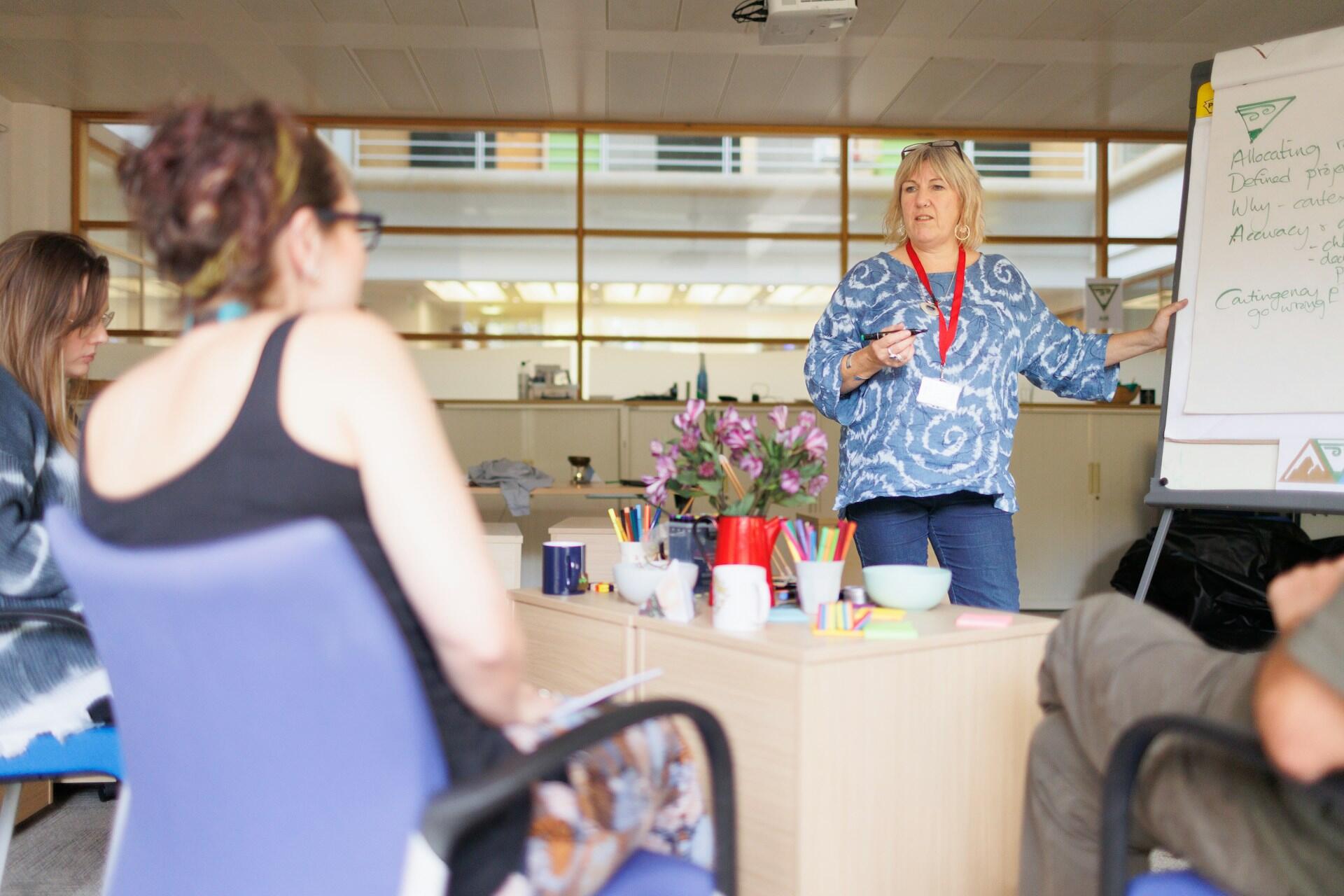ESL classes should be based on good lesson plans. This will make your students learn more effectively and make your job as a teacher much more manageable.
Whether working with beginners or advanced learners, structuring your lessons is necessary. Here's our guide to lesson plan structures, some creative ideas, and how to get the most out of your ESL curriculum.

Why Lesson Plans Are Essential for ESL Teaching
Lesson plans are key to successful ESL teaching. They give you and your students a clear outline of what will be covered, how you'll teach it, and how you'll measure the efficacy of the lesson and overall course.
ESL teachers should use plans to keep lessons focused and manage timings, even if these mightn't always be followed to the letter.
Effective ESL lessons should help students by offering activities targeting the lesson's specific vocabulary, grammar, and speaking skills. Your lesson plans can also form a structure you can adapt to different levels, from beginners to advanced learners.
The Core Structure of an ESL Lesson Plan
A lesson plan is essential for clarity and consistency in the classroom. It will help you stay organized and give your students a better idea of what they need to do.
1. Define the Learning Goals: Set Clear and Measurable Objectives
Setting clear objectives at the beginning of a lesson will help you and your students stay focused. The lesson and learning objectives will outline what a student should have learned by the end of the lesson. Refer back to them at the end of your lesson so you know what to cover for the next lesson and your students know what they should study between now and the next session.

Example: "Students will be able to introduce themselves using basic English sentences."
Clearly defined goals help ensure students know what to expect and allow teachers to measure progress effectively.
2. Materials and Essential Resources: Arrive Ready
In your lesson plan, include a materials and resources section. This way, you can gather all the necessary resources before teaching a class or a private student lesson.
Common ESL Materials:
Flaschards
For vocabulary building
Worksheets
For grammar practice
Audio recordings
For listening exercises
Props or realia
For teaching basic language concepts
Organize your materials before class for smoother lesson delivery.
Lessons will run much more smoothly if you don't have to look around for what you need. You should also store your lesson plan and resources in a plastic binder. However, this mightn't be possible if you use the same resources for several lesson plans. In this case, it's worthwhile noting in the resources section where you keep these resources.
3. Warm-Up Activities: Get Students Ready to Learn
Warm-up activities are great for getting students ready for learning rather than immediately bombarding them with the core content of the lesson. Remember that ESL students might need a few minutes to transition into English.
Warm-Up Ideas
Students brainstorm words related to the lesson's vocabulary.
Ask simple questions like, “What did you do last weekend?”
Warm-ups are especially useful in ESL classes to break the ice and get students comfortable speaking in English, which is one of the key barriers to learning in most language classes.
4. Presentation: Introducing New Concepts
The presentation part of the lesson is where the teacher introduces the new vocabulary, grammar, or sentence structure that will be covered during the lesson. This is an essential part of the lesson, but it's often the least engaging, so do everything you can to make it interesting.
Presentation Methods
- Visual Aids: Use flashcards and pictures for basic vocabulary.
- Demonstrations: Model sentences and encourage repetition.
- Video Clips: Show short videos that demonstrate language use in context.
Break down concepts into more straightforward steps, allowing learners to build confidence and understanding.

5. Practice Activities: Reinforcing Lesson Objectives
Once you've explained the concepts that students will be learning in today's lesson, it's time to practice in a structured and controlled environment. These activities should be low-pressure and low-stakes so that concepts click with students. You can test their knowledge of the lesson objectives later.
Practice Ideas
- Fill-in-the-Blank Exercises: Helps reinforce grammar structures.
- Matching Games: Great for teaching vocabulary to younger students.
- Sentence Building Cards: Encourage students to create simple sentences.
For beginner ESL students, keep practice activities short and focused on basic vocabulary and sentence structures.
6. Production: Independent Practice
Production activities are when you take the training wheels off or remove the safety let. Here, students can apply what they've learned to situations more similar to those they'll experience using their English in real-life settings.
Production Ideas
- Role-Playing: Assign real-life scenarios like ordering food or introducing themselves.
- Storytelling: Have students create a short story using new vocabulary.
- Peer Interviews: Encourage students to ask and answer questions in pairs.
At this stage, students can gain fluency and build up their confidence. With language learning, a confident speaker is far more likely to engage with your lesson content and develop their English language skills more quickly.

7. Wrap-Up: Review the Key Concepts
The wrap-up phase is a nice way to give students a victory lap, showcasing the new concepts they've learned and hopefully mastered. This doesn't necessarily have to be as difficult as the earlier step.
Wrap-Up Ideas
- Exit Tickets: Ask students to write one new word or sentence they learned.
- Class Recap: Review the main points covered in the lesson.
- Q&A Session: Allow students to ask questions about the material.
A strong conclusion helps students retain new language skills while providing the teacher with immediate feedback on lesson effectiveness.
8. Homework: Learning Beyond the Classroom
Homework allows students to continue practicing the key lesson objectives and reduces their likelihood of forgetting them by the next session.
Homework Ideas
- Journaling: Write a paragraph using new vocabulary.
- Online Quizzes: Interactive grammar quizzes are available on platforms like Kahoot.
- Video Tasks: Watch an English video and summarize the content.

Creative ESL Lesson Plan Ideas for Different Levels
Here, we'll look at some effective structures for planning ESL lessons. We'll use the structure we outlined earlier, but you'll need to find the exact materials, ensuring they're suitable for your students.
1. Beginner – Daily Routines
For this sample lesson, you'll teach students how to describe daily routines using the present simple tense.
- Objective: Describe daily routines. Present simple tense.
- Materials: Flashcards, worksheet, clock.
Activities
Warm-Up
Charades with routine actions.
Presentation
Introduce common daily verbs like wake up, brush teeth, eat breakfast.
Practice
Worksheet matching routines to pictures.
Production
Students write and share personal daily routines.
2. Intermediate – Describing People
This is a lesson that focuses on adjectives and describing both physical appearances and personality using them.
- Objective: Vocabulary building: common adjectives.
- Materials: Picture cards, adjective lists, sentence strips.
Activities
Warm-Up
Describe a celebrity.
Presentation
Introduce descriptive adjectives with examples.
Practice
Pair work where students describe each other.
Production
Create "wanted posters" with written descriptions.
3. Advanced – Debate Skills
This is an advanced lesson in which students use persuasive language skills. However, it could also be simplified for intermediate students who want to express opinions.
- Objective: Use persuasive language.
- Materials: Debate topics list, timer, debate structure chart.
Activities
Warm-Up
Quick opinion poll on a popular topic.
Presentation
Presentation: Explain debate structures and phrases like "I believe..." and "On the other hand..."
Practice
Small group debates on lighter topics.
Production
Full-class debate with timed arguments.
Tips for ESL Teachers
ESL teaching is really rewarding, but it can be quite challenging between lesson planning and teaching the lessons themselves. Making lesson plans can make things a little easier but can also become a burden. Get the most out of your lesson plans with these tips.
- Stay Flexible: Adapt your lesson plans based on the class size and language level.
- Use Mixed Media: Incorporate videos, audio, and physical materials for a dynamic experience.
- Encourage Peer Learning: Group activities foster collaboration and language practice.
- Incorporate Games: Use fun ESL games and activities like Bingo or Simon Says for vocabulary review.
Remember that your lesson plan is there to help you. If something isn't working, you don't need to stick to the plan exactly. A good teacher will read the room and adapt lessons and activities on the fly when necessary.
Work smarter, not harder, too. You can use older lesson plans as the structure rather than planning every lesson plan from scratch. You'll remember which sessions went well and which activities worked. Have fun with them!
















